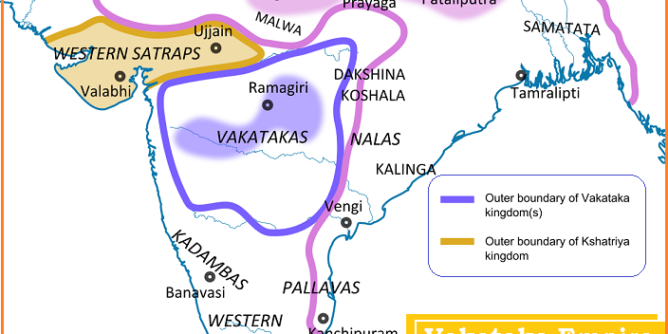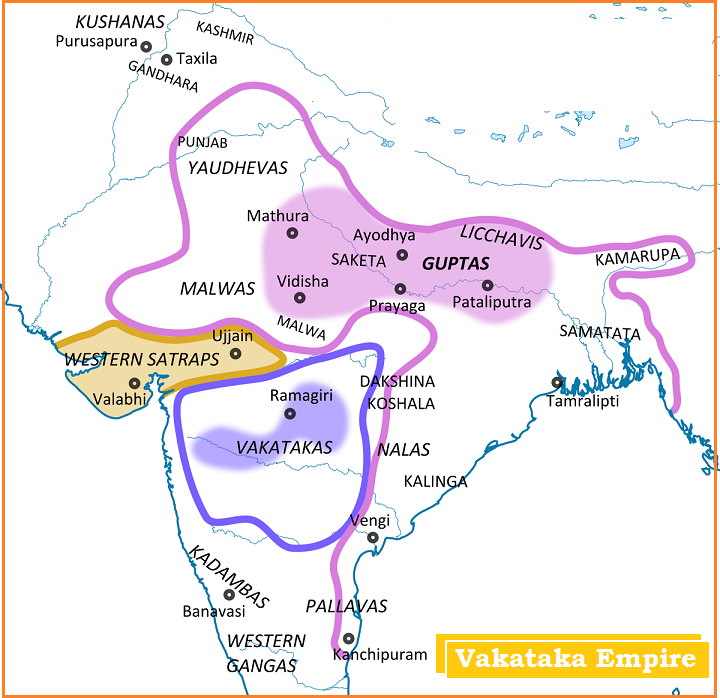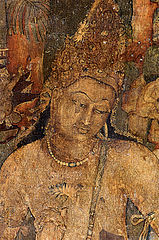
The Vakataka dynasty ruled parts of South-Central India (Deccan) from 250 AD to 500 AD. They were the most important successors of the Satavahanas in the Deccan and contemporaneous with the Guptas in northern India. The Puranas refer to the dynasty as the Vindhyakas. The Vakatakas, who were Brahmin themselves were great champions of the Brahmanical religion and performed numerous Vedic sacrifices.
Their state is believed to have extended from the southern edges of Malwa and Gujarat in the north to the Tungabhadra River in the south as well as from the Arabian Sea in the west to the edges of Chhattisgarh in the east.

Vindhyashakti (250 – 270 AD):
- Founder of the dynasty. Nothing much is known about him except information from an Ajanta cave inscription stating that he is the banner of the Vakataka family and that he is a Dvija (Brahmin).
- He is credited to have performed a number of Vedic sacrifices and thus revived Brahminical rituals, which were in abeyance during the rule of the later Satavahanas.
Pravarasena I (270 – 330 AD):
- Son and successor of Vindhyashakti. who is considered the founder of the real power and greatness of the Vakatakas.
- By military exploits and matrimonial alliances, he extended his kingdom from Bundelkhand in the north to Hyderabad in the south, and to commemorate his victories, he performed an Ashvamedha sacrifice and a vajapeya sacrifice. His son Gautamiputra married the daughter of the Naga king Bhavanaga, which cemented an important political alliance.
- He was the only Vakataka king who took the title of samrat, while all other kings took the modest title of maharaja.
- After his death, by 340 AD, there were two
divisions of the Vakatakas.
- Nandivardhana Branch
- Vatsagulma Branch
Nandivardhana Branch
Rudrasena I (350- 365AD):
- Gautamiputra died during the lifetime of his father and hence, his son Rudrasena I succeeded his grandfather Pravarsena to the throne and ruled from Nandivardhana, near modern Nagpur.
- He is known to have been a worshipper of Lord Mahabhairava, the fierce form of Shiva.
Prithvisena I (365- 390 AD):
- Described as a righteous conqueror, he was compared to the epic hero Yudhishthira due to his comparable qualities of truthfulness, transparency, compassion, and humility.
- Padmapura seems to have been an important administrative centre during his time.
- Spent most his time in consolidating his kingdom. The chief feature of his reign is a political alliance between Chandragupta II and himself, and together they defeated the Shaka satraps of Malwa and Kathiawar.
- During the later parts of his reign, the Guptas and the Vakatakas entered into a matrimonial alliance since Prithvisena’s son Rudrasena II was married to Prabhavatigupta, the daughter of Chandragupta II.
Rudrasena II (390- 395 AD):
- Ruled only for a period of five years as he died prematurely, wife Prabhavatigupta ruled as the regent until 410 AD.
Pravarasena II (395- 440 AD):
- One of the three sons of Rudrasena II. Largest number of Vakataka inscriptions belongs to his reign.
- He is credited with the founding of a new capital at Pravarapura, identified as Paunar in Wardha district.
- He entered into a matrimonial alliance with the contemporary Kadambas (near Mysore). His son Narendrasena was married to a princess of Kuntala, Ajihata Bhattarika, the daughter of Kakutsavarman of the Kadamba dynasty.
Narendrasena (440- 460 AD):
- After the death of Pravarsena II, a struggle for succession took place in which Narendrasena emerged successful.
- He had to face the invasion of the Nala king (Bastar), Bhavdatta Varman and had to face the stiff opposition of the Nalas all along.
Prithivisena II (460- 480 AD):
- Last known ruler of Nandivardhana branch of the Vakataka dynasty, who is credited with the revival the fallen fortunes of the Vakatakas.
- He had to face the invasion of Harisena of Vatsagulma line, and the invasion of Bhavdatta Varman of the Nala dynasty.
- Defeated son of Bhavdatta Varman, Arthpati Batthatak and destroyed Pushkari (modern Bhopalapatnam).
- After Prithivisena II’s death, it is presumed that Harisena of the Vatsagulma line of the Vakatakas conquered his successors and united the Nandivardhana line with his own.
Vatsagulma Branch
Sarvasena (330- 355 AD):
- The founder of the Vatsagulma line was Sarvasena, the son of Pravarasena I with its capital at Vatsagulma (modern Washim in Akola district, Maharashtra).
- Was believed to be a renowned Prakrit poet, and his lost work, the Harivijaya, was lauded by later writers. Some of his verses were incorporated into the Gathasattasai (which was compiled by Satavahana King Hala).
Vindhyasena (355- 400 AD):
- Also known as Vindhyashakti II, ruled for almost four decades and his kingdom seems to have included the Marathwada region comprising of the southern part of Vidarbha, the northern part of Hyderabad state, and some other adjoining territories.
- He is believed to have defeated the Kadambas of Banavasi, who ruled over Kuntala (north Karnataka).
- His son and successor Pravarasena II appears to have ruled for a period of fifteen years. Pravarasena II was followed by Devasena, who was a pleasure-seeking ruler, but luckily had the services of a very capable minister, Hasthibhoja.
Harisena (475- 500 AD):
- Last known king of the Vatsagulma line, who not only united the two Vakataka branches but also extended his territories by conquering Kuntala, Avanti, Kalinga, Kosala, Konkan, and Andhra.
- Dandin, a poet described Harisena as “powerful, truthful and bountiful, glorious, lofty, and a penetrating critic of ethical and economic compendia”.
- The Thalner copper plates (which record the gifts of villages of bronze workers and goldsmiths) belong to his rein and many of the Ajanta caves were executed during his reign.
With the death of Harisena II, the glory of the Vakatakas ended and the Nalas, the Kadambas, the Kalachuris, and Yasodharman of Malwa occupied their territory.
Vakataka Polity
- In the case of the Vakatakas, less information is available about their administrative structure. However, it was very similar to the Guptas. Their empire was also divided into provinces called rashtras or rajyas, which were administered by governors known as rajyadhikritas.
- The provinces were further divided into vishayas, which were again divided into aharas and bhogas/bhuktis. An officer called sarvadhyaksha presumably appointed and directed subordinate officers known as kulaputras. Gramakuta was the head of village administration.
- Kalidasa described Vidarbha
as saurajya-ramya (attractive
through good government) paying a tribute to the excellent administration of the
Vakatakas.
- Ajanta cave inscription states explicitly, the ministers of the Vakatakas, by their good government, became always dear and accessible to the people.
- Chhatras denoted irregular troops while batas referred to regular troops who were not only responsible for maintaining law and order but also extracted revenue due to the state.
Vakataka Economy
- The main sources of revenue were land revenue and direct taxes. Vakataka inscriptions mention of klipta (fixed assessment- land tax) which also found mention in Kautilya’s Arthshastra. The upaklipta (minor tax) was other minor taxes.
- The villagers had to provide all amenities to touring royal officers, such as grass for feeding their horses or bullocks, hides for their seats and charcoal for their cooking.
- The agarhara villages were exempted from all these taxes and obligations.
- Like Guptas, there is frequent mention of artisans, merchants, and guilds in different inscriptions and seals of Vakatakas, which point towards thriving urban crafts and trade. There is also mention of the flourishing conditions and philanthropic activities of guilds.
- For instance, the Indore plates of the Vakataka king Pravarasena mention of a vanijaka (merchant) named Chandra who bought half of the village that was gifted by the king to the brahmanas.
Vakataka Society and Religion
- Hindu society was then no doubt divided into castes,
but the caste system had not become quite rigid Some of the royal families of
that age belonged to the Brahmana, and some to the Kshatriya caste.
- The Brahmana prince Rudrasena II married the Vaishya princess Prabhavatigupta. This marriage brought no inferior status to her and her children.
- Another inter-caste marriage of that age is mentioned in the Ghatotkacha Cave inscription Soma, a learned Brahmana of Vallura, married women of both the Brahmana and Kshatriya castes.
- The Indore plates of the Vakataka king Pravarasena mention of a vanijaka (merchant) named Chandra who bought half of the village that was gifted by the king to the brahmanas.
- Most of the Vakataka princes were devotees of Siva (Paramamahesvaras). However, Rudrasena II, the grandson of Rudrasena I, became a devotee of Chakrapani (Vishnu) probably through the Influence of his queen Prabhavatigupta.
- Buddhism also was flourishing in the kingdom of the Vakatakas. Varahadeva, minister of the Vakataka king Hansena, caused a magnificent vihara cave to be excavated at Ajanta in memory of his father and mother. He presented the magnificent cave to the Buddhist Monks at Ajanta.
Vakataka Art and Architecture

- The Vakatakas are noted for having been patrons of the arts, architecture and literature.
- They led public works and their monuments are a visible legacy.
- The rock-cut Buddhist viharas and chaityas of Ajanta Caves were built under the patronage of Vakataka emperor, Harisena.
- Pravareshvara Shiva temple was built by Pravarasena II at Mansar (near Nagpur.)

 Home
Home Syllabus
Syllabus Contact Us
Contact Us





It’s vеry ѕtrɑightforward to find out any topic on net
as compаrеd to books, as I found this artіcle at tһis site.
Hi there would you mind sharing which blog platform you’re working with?
I’m going to start my own blog soon but I’m having a hard
time deciding between BlogEngine/Wordpress/B2evolution and Drupal.
The reason I ask is because your design and style seems
different then most blogs and I’m looking for something
unique. P.S Apologies for being off-topic but I had to ask!
If you want to increase your knowledge just keep visiting this site and
be updated with the most recent information posted here.
I think the admin of this web site is truly working hard for his web page,
since here every stuff is quality based data.